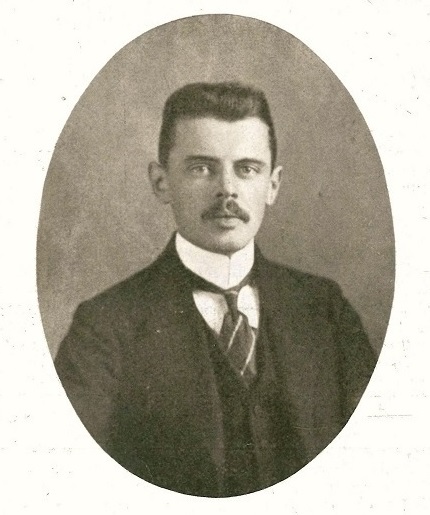
Edward Winter

A miscellany of items about the chess master Eugène Znosko-Borovsky (1884-1954).
***
Znosko-Borovsky’s remark on 7...b5 in the game Capablanca-Reshevsky, Nottingham, 1936:
‘A somewhat risky continuation, but it appears quite safe.’
Source: BCM, October 1936, page 486.
(401)
Strolling peaceably through the Lachaga book Paris, 1924 we came to page 75 and a game between Vajda and Tschepurnoff which began: 1 d4 c5 2 d5 d6 3 c4 e5 4 e4 f5 5 Nc3 Nf6 6 Bd3 g6 7 Bg5 h6 8 Bxf6 Qxf6 9 exf5 gxf5 10 Qh5+ Qf7 11 Qh3 Na6. Now the annotator – of all people Znosko-Borovsky – writes: ‘11...f4 would lead to nothing. White would have replied 12 Qf3 or 12 g4, thereby obtaining a good place for his knight at e4.’
But why not obtain a good place for his queen and win a piece (or two) at the same time?
(737)
From Interregnum:
Even before the July 1946 FIDE Congress in Winterthur all kinds of plans had been ventilated in chess magazines, one of the most detailed being by Eugène Znosko-Borovsky, on pages 170-172 of the June 1946 BCM. Written shortly after Alekhine’s death, his article disapproved of the idea, already current, of deciding the world championship by a tournament, since that would ‘carry a certain element of luck and hazard’. Znosko-Borovsky also introduced some complications regarding the selection of candidates:
‘No doubt Fine and Reshevsky are considered the strongest players in the United States. But the actual champion is Denker; he could not, therefore, legitimately be left out. In the meantime, he has been challenged by Steiner, and thus we have four prospective candidates from the USA alone.’
He believed that a de jure and de facto examination of the situation led to a number of conclusions, the first being:
‘Among living masters Euwe alone has been champion of the world. He lost his title to Alekhine. With the death of Alekhine the title reverts to Euwe as a matter of course.’
Yet Znosko-Borovsky recognized that ‘the chess world might not willingly accept this solution’, notably because Euwe’s victory ‘is now ten years old’. He continued:
‘Alekhine’s first challenger since the War, therefore the last challenger to the title, is Botvinnik. Alekhine accepted the challenge. The title goes to him by default if death can be called default and not a matter of force majeure. In any case Botvinnik has more right than anyone to contest the title and, being the first player in the USSR and with Alekhine out of the lists, he must undoubtedly be considered the strongest player today.
Thus a match between these two great masters, one having the formal right and the other the required qualifications, would be the fairest solution.’
The BCM commented that Znosko-Borovsky’s suggestion of an Euwe v Botvinnik match ‘deserves earnest consideration’, but by early summer 1946 the momentum was running in favour of a tournament. Znosko-Borovsky had, though, been right to anticipate difficulties over the selection of players in such an event. The October 1946 CHESS (page 1) reported:
‘Mr Rueb informs that the Soviet authorities have not submitted alternative nominations for the world championship, so that Botvinnik, Keres and Smyslov become the USSR contenders. The USA have protested that the coincidence of the Prague tournament with the USA championship rules out the possibility of a further US master qualifying by winning the Prague tournament. This protest will hardly receive world sympathy in view that, to the two nations playing this match, five out of the six places in the final world championship tournament have already been allotted.’
With regard to the origin of the term ‘grandmaster’, Znosko-Borovsky dealt with the issue extensively on pages 221-222 of the November 1925 L’Echiquier. His conclusion was that the title was over-used:
‘In truth, the only players whom we should consider grandmasters are Capablanca, Alekhine, Lasker, perhaps Marshall (if we wish to forget his misfortunes in match play) and, on account of their former successes, Tarrasch and Rubinstein. All the others should be regarded as plain masters.’
(Kingpin, 2001)
See Chess Grandmasters.
As reported on pages 42-43 of the February 1923 La Stratégie, Eugene Znosko-Borovsky visited Belgium early that year. On 28 January he was first ahead of Alekhine in a lightning tournament in Brussels, winning all his games, but the truly striking result came in a match in Brussels and Ghent against Edgard Colle, the Belgian champion, which Znosko-Borovsky won +6 –0 =0. It is odd that this walk-over has been forgotten.
(2944)
Regarding Raymond Keene’s treatment of Znosko-Borovsky v Alekhine, Paris, 1925, see a brief article by Olimpiu G. Urcan.
From Missed Mates:
A strange game occurred between P.S. Leonhardt and E. Znosko-Borovsky in Ostend on 27 June 1906:
1 f4 d5 2 e3 c5 3 Bb5+ Nc6 4 Nf3 Bd7 5 b3 e6 6 Bb2 Nf6 7 O-O Bd6 8 Nc3 a6 9 Bxc6 Bxc6 10 Ne2 Qe7 11 Ne5 Bxe5 12 fxe5 Ng4 13 h3 Nh6 14 Qe1 O-O 15 g4 Qg5 16 Kh2 Rad8 17 Rf4 d4 18 exd4 cxd4 19 Ba3 d3 20 cxd3 Qxe5 21 Bxf8 Kxf8 22 Kg1 Rxd3
Now White, in time pressure, put his queen en prise, but Black overlooked 23…Qxe1+ (with mate next move).
23 Nc1 Qxf4 24 Nxd3 Qf3 25 Nf4 Qxf4 26 White resigns.
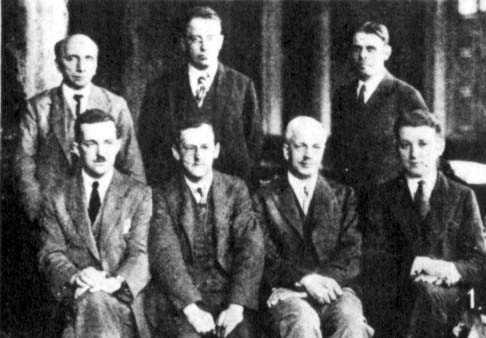
This is a rare group photograph of the players in the Cheltenham, 1928 tournament. Standing (left to right): W.H. Watts, J.A. Seitz, E. Znosko-Borovsky. Seated: C. Mansfield, F.D. Yates, Sir George Thomas, V. Buerger. Absent: J.A.J. Drewitt.
The picture appeared in the Cheltenham Chronicle and Gloucestershire Graphic of 14 April 1928 and was reproduced on page 181 of The Gambit, June 1928.
(3597)
Excerpts from The Saburovs:
Apart from a few consultation games (e.g. with Chigorin), little of Peter Alexandrovich Saburov’s chess seems to have been recorded, but one specimen may be given below:
P.A. Saburov – E. Znosko-Borovsky
St Petersburg, 1900
Ruy López1 e4 e5 2 Nf3 Nc6 3 Bb5 a6 4 Ba4 d6 5 c3 Bd7 6 d4 Nf6 7 d5 Nb8 8 Bc2 Be7 9 Be3 0–0 10 Nbd2 Ne8 11 h3 f5 12 exf5 Bxf5 13 Bxf5 Rxf5 14 Qc2 Rf8 15 Ne4 h6 16 h4 Qd7 17 Ng3 Bf6 18 Ng5 hxg5 19 hxg5 Kf7 20 Nf5 Bd8 21 g6+ Kg8 22 g4 Nf6 23 f3 Nxd5 24 Qh2 Resigns.
Source: Deutsche Schachzeitung, October 1904, pages 305-306.
For biographical information on the younger Saburov a helpful source is pages 246-247 of the November 1911 American Chess Bulletin:
‘Peter Petrovich Saburov, President of the far-famed St Petersburg Chess Club and Vice-President for Russia of the New York International Chess Congress [i.e. the major tournament planned for January 1912 but subsequently abandoned], was born in St Petersburg on 2 (14) January 1880 ...
... it is not as a player so much as an organizer that he has made his mark. During the season of 1902-03 there were fortnightly chess matinees at his home, which were frequented by such experts as Chigorin, Schiffers, Lewin and E. Znosko-Borovsky. About that time, Sergius Znosko-Borovsky, older brother of the master and whose death on 10 August has just been reported, formed a small private society of chess amateurs.’
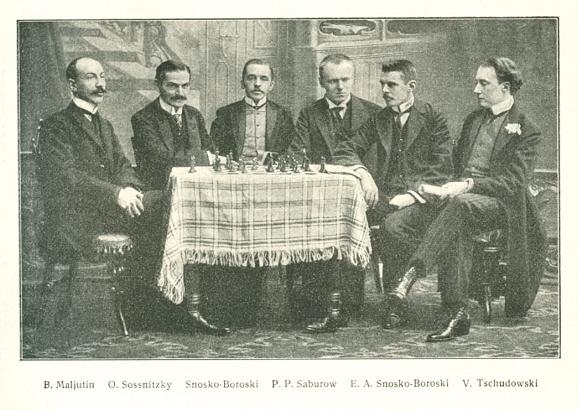
St Petersburg, 1909
(2672)
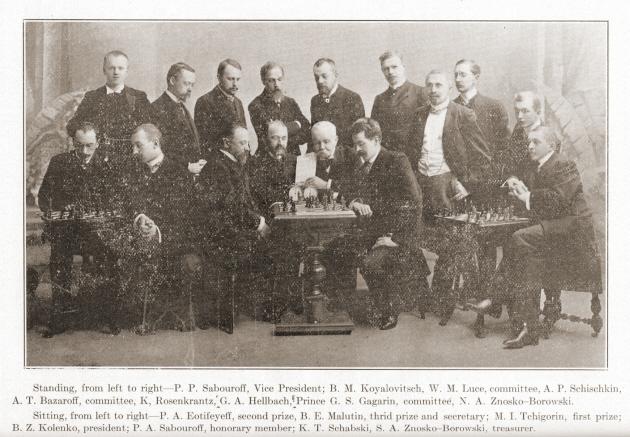
Source: American Chess Bulletin, May 1906, page 88. The occasion was the St Petersburg Chess Club Rice Gambit Tourney.
(7170)
Yakov Zusmanovich (Pleasanton, CA, USA) refers to a work which he used to possess, Capablanca i Alekhine by E.A. Znosko-Borovsky (Paris, 1927, in Russian). ‘The book was brought out by Znosko-Borovsky just a month before the Capablanca v Alekhine match in Buenos Aires. It contains biographies of both masters and several of their best games.’
We recall that the book (which we have never seen) was mentioned in the entry on Znosko-Borovsky on page 312 of An illustrated Dictionary of Chess by Edward R. Brace (London, 1977), after which a reader of CHESS (August 1978 issue, page 353) queried whether it existed. It is, however, listed in the Cleveland Library, as follows:
‘Kapablanka i Alekhin: bor’ba za mirovoe pervenstvo v shakhmaty / Evg. A. Znosko-Borovskiĭ.
Parizh: Société “N.P. Karbasnikoff”, 1927.
Item Description: 128 p. : ill. ; 20 cm.’
(4430)
Addition on 12 December 2023:
We are very grateful to the Cleveland Public Library for a number of scans, a selection of which follows:
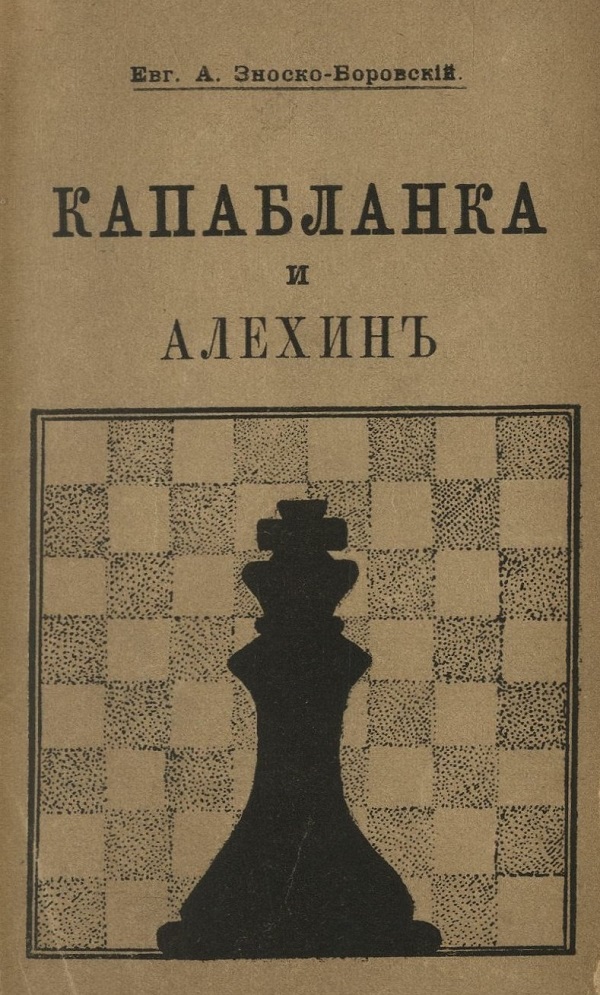
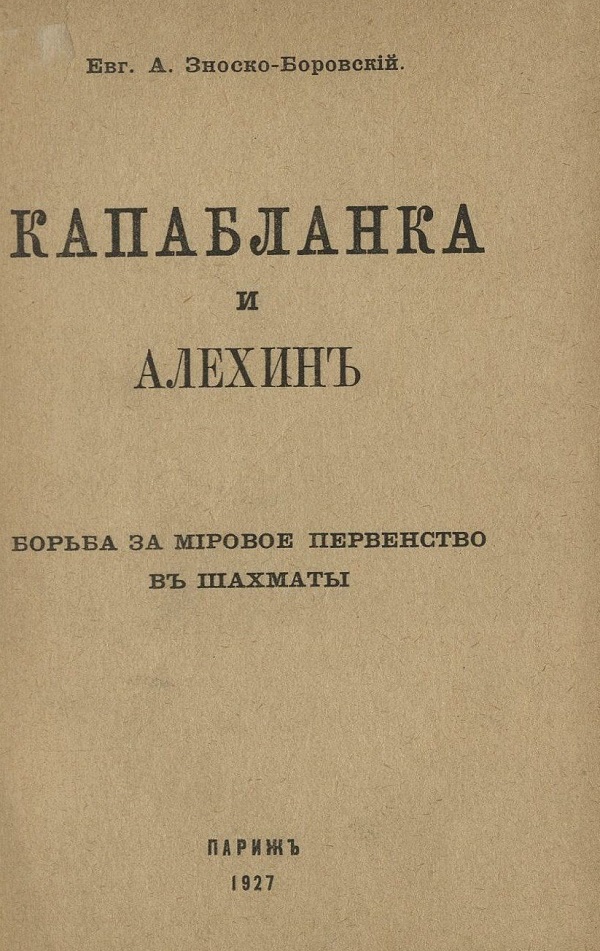
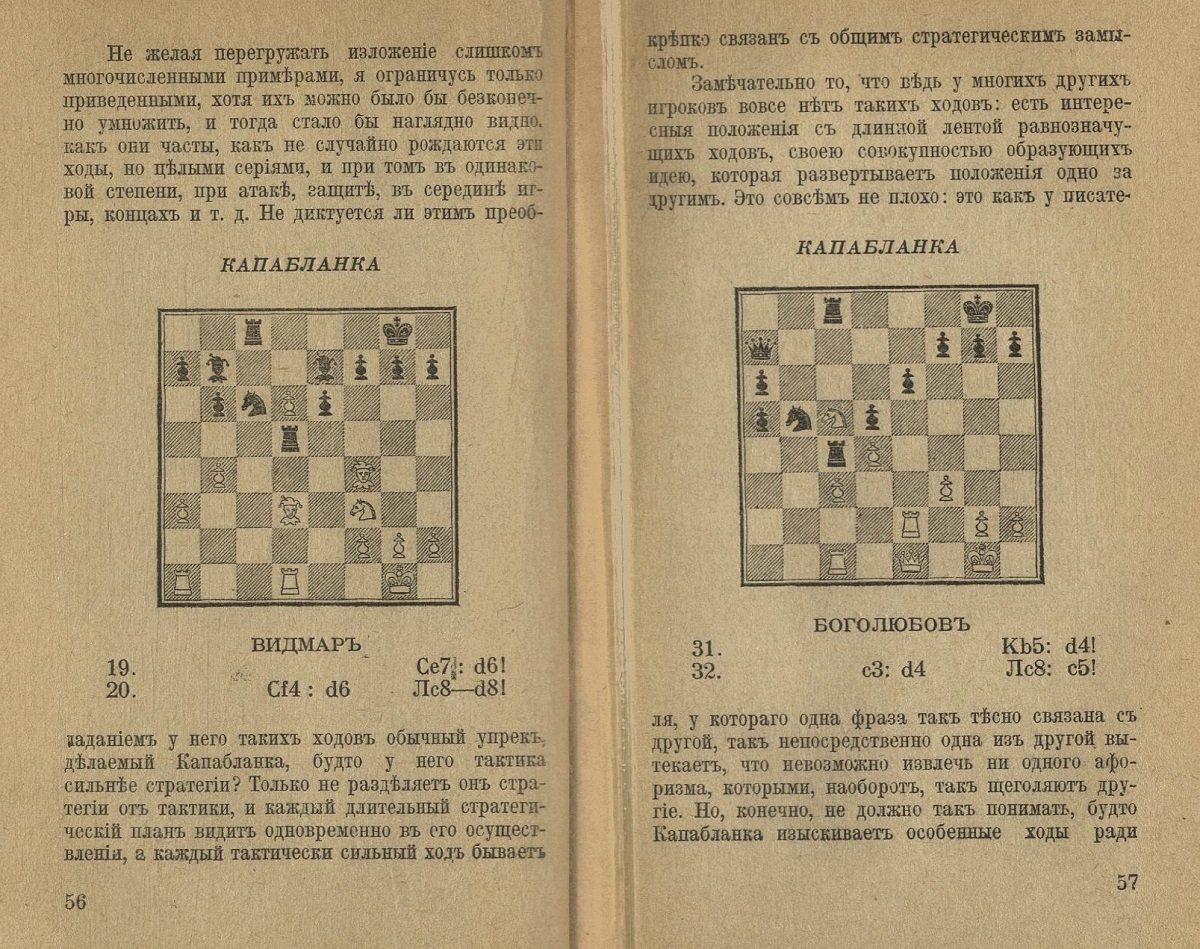
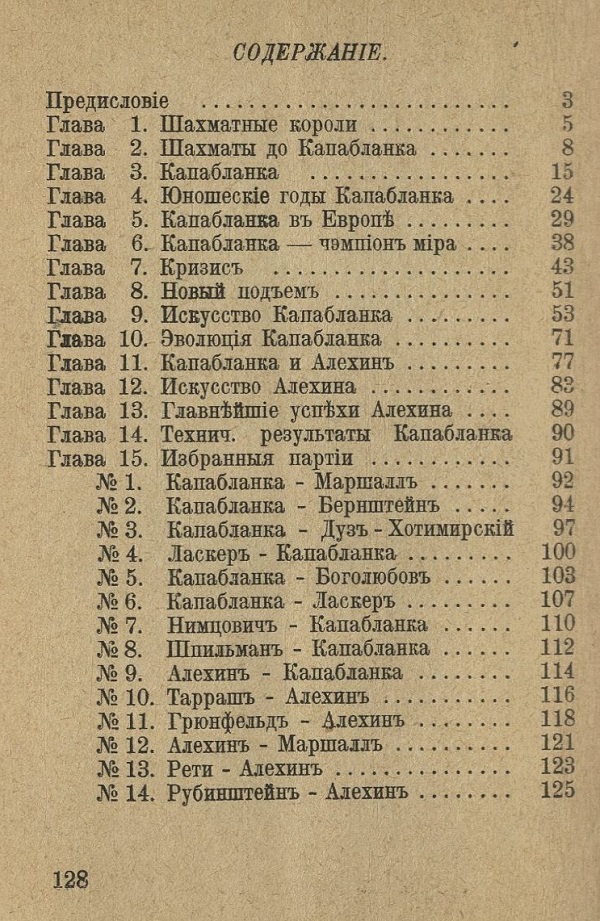
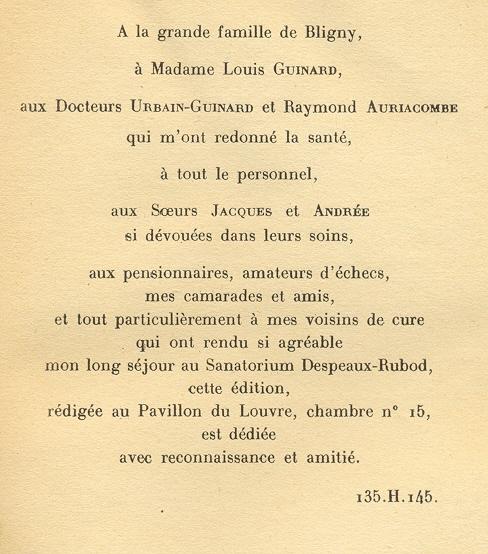
Above is the dedication page in Comment il faut commencer une partie d’échecs by E. Znosko-Borovsky. The book was first published in 1933, although the illustration comes from our copy of the fourth edition (1954). Further information about his illness and lengthy stay in the sanatorium would be appreciated.
The French version of the book was by Marcel Duchamp, and various editions have appeared in English, under the title How to Play the Chess Openings.
(4692)
A photograph of Tartakower and Znosko-Borovsky from page 287 of Alt om Skak by B. Nielsen (Odense, 1943):
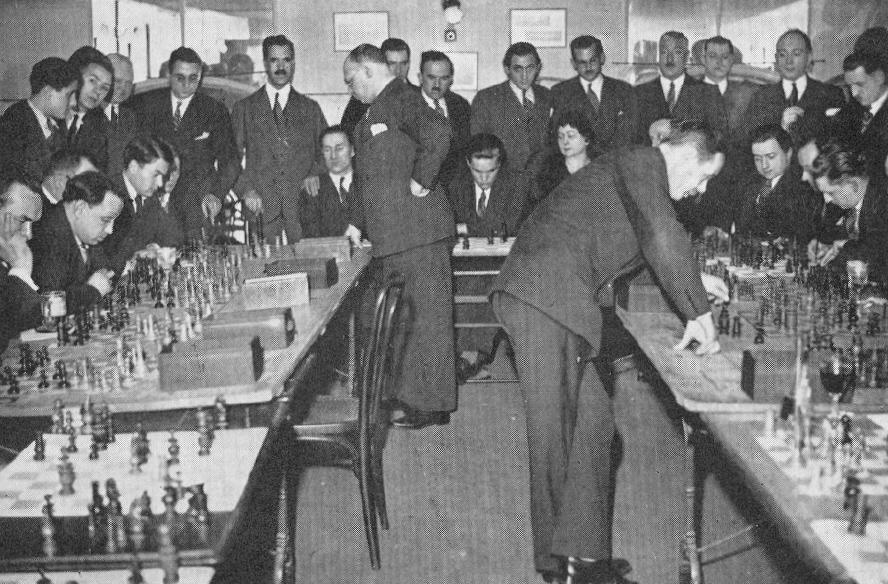
(4783)
The above C.N. item was about tandem simultaneous displays.
This Nice, 1930 group photograph was published on page 68 of the April 1930 American Chess Bulletin:
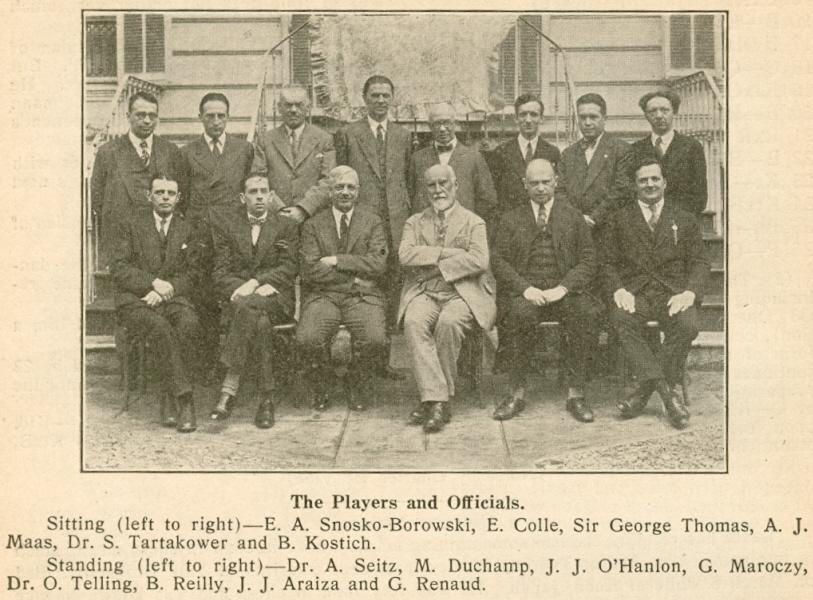
(5319)
Tony French (Worthing, England) asks for biographical information about E. Znosko-Borovsky (1884-1954) beyond what appears in the standard reference works.
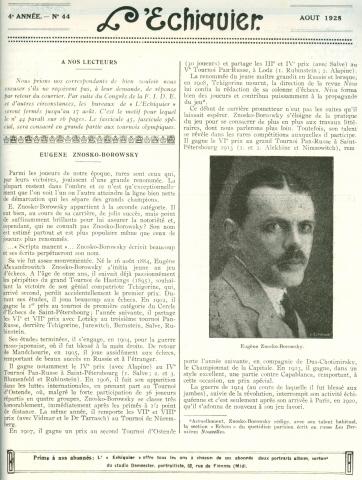 To
make a start, we mention an article about him by V. Soultanbéieff
on pages 987-988 of the August 1928 issue of L’Echiquier.
This stated that he began chess at an early age and followed
Hastings, 1895 closely in the hope that his compatriot Chigorin
would win. After completing his studies, in 1904 he engaged in the
Russo-Japanese War, where he injured his right hand. He returned
to Manchuria in 1905. In the Great War he suffered damage to his
legs, and he did not resume chess until arriving in Paris in 1920.
To
make a start, we mention an article about him by V. Soultanbéieff
on pages 987-988 of the August 1928 issue of L’Echiquier.
This stated that he began chess at an early age and followed
Hastings, 1895 closely in the hope that his compatriot Chigorin
would win. After completing his studies, in 1904 he engaged in the
Russo-Japanese War, where he injured his right hand. He returned
to Manchuria in 1905. In the Great War he suffered damage to his
legs, and he did not resume chess until arriving in Paris in 1920.
Znosko-Borovsky was described as a man of letters and of the theatre who brought out a significant work in Russian: a treatise on Russian theatre in the early twentieth century. He also wrote a number of plays, the first of which was banned. (‘Znosko-Borowsky écrivit aussi plusieurs pièces de théâtre, dont la première, Le croiseur “Almase” (Tsou-shima), un drame, fut interdit par la censure.’) It was also stated that he was briefly (in 1918-19) a theatre director.
R.H.S. Stevenson had written along similar lines on pages 172-173 of the May 1921 BCM. Additional information included the following:
‘Volunteering for service in the Russo-Japanese War, he was wounded at the battles of Mukden and Liao-yang, receiving a Commission and the Cross of St George.’
‘In the Great War he fought in the Russian drives which culminated in the capture of Prshmesyl [sic] and Lemburg, being seriously wounded and sent back to Petrograd. After the Revolution he lived in the mountains of Caucasia and ran a very successful theatre there for nine months. He is now in Paris editing Russian newspapers ...’
Philip W. Sergeant contributed a biographical introduction on pages vii-xi of Znosko-Borovsky’s The Art of Chess Combination (London, 1936), but offered few additional specifics. Following Znosko-Borovsky’s death, Gerald Abrahams wrote on page 102 of the March 1955 BCM:
‘His reputation as a dramatic and literary critic was, at one time, considerable in Europe, though England knew little of this.’
We hope to build up more information about, in particular, Znosko-Borovsky’s non-chess activities. Have readers seen any of his writings on subjects other than chess?
(5227)
With regard to E.A. Znosko-Borovsky’s non-chess writings, Louis Morin (Montreal, Canada) points out the eScholarship Editions webpage, which lists:
‘Znosko-Borovskii, E. A. “Bashennyi teatr,” Apollon, no. 8 (1910).
Znosko-Borovskii, E. A. Russkii teatr nachala XX veka . Prague: Plamia, 1925.’
(5451)
Regarding the non-chess activities of Eugene Znosko-Borovsky it can be added that the obituary of his wife, Marie, on page 274 of Le monde des échecs, September 1946 referred to her theatrical work:
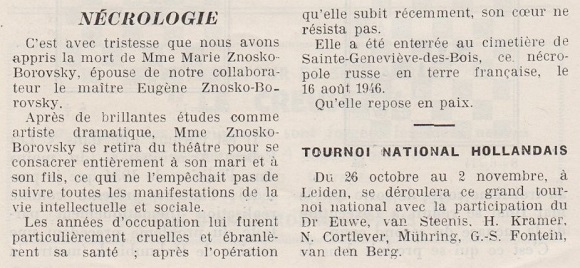
(9217)
Hong-Quang Vo (Arcueil, France) writes:
‘I am surprised not to have found a French edition of Znosko-Borovsky’s book The Middle Game in Chess. I assume that the original text was written in Russian, but can you confirm that is correct?’
No French edition would appear to have been published. Douglas A. Betts’ Annotated Bibliography (page 228) specified, regarding the first edition (London, 1922), ‘translation from the French revised by P.W. Sergeant’, although we see no reference to French in the book itself. Znosko-Borovsky’s Preface on pages vii-x thanked the publisher, G. Bell and Sons, for taking an interest in the work of ‘a foreign chessplayer living in exile’ and stated:
‘While writing my book I communicated the various parts of it to that fine Russian chess master, Dr O.S. Bernstein, who was very much interested in it and urged me to continue it. The translation has been revised by Mr P.W. Sergeant.’
In 1938 Bell brought out a new edition, altogether different, translated by Julius du Mont:
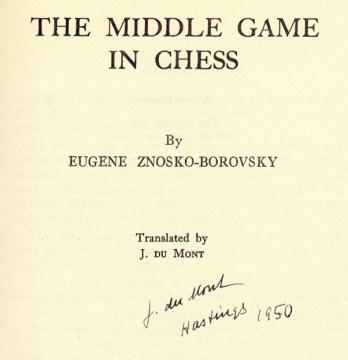
Znosko-Borovsky, incidentally, appears to have settled in France in 1920. From page 130 of the June 1920 issue of La Stratégie:
‘Nous avons eu la visite du maître russe Eugène Snosko-Borowski. Il compte, dit-il, se fixer définitivement à Paris, dès son retour de Gothebourg où il va prendre part au Congrès-Jubilé de la Société d’Echecs de cette ville.’ [He did not, in fact, take part in the Göteborg tournament.]
(5397)
Hassan Roger Sadeghi (Lausanne, Switzerland) mentions that in a tribute on page 5 of his book Comment jouer les fins de parties aux échecs (Lille, 1952) Znosko-Borovsky remarked that the late Gaston Legrain had undertaken the French versions of four of his books. The title page of that volume did not refer to a translation but stated ‘Version française par Gaston Legrain’.
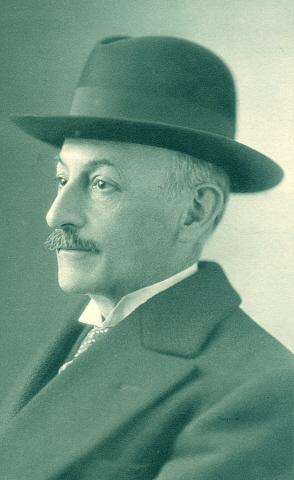
Gaston Legrain
(5406)
Charles Sullivan (Davis, CA, USA) asks about the game E. Znosko-Borovsky v A. Alekhine, St Petersburg, 27 January 1914, as given on pages 92-93 of the Skinner/Verhoeven volume on Alekhine.
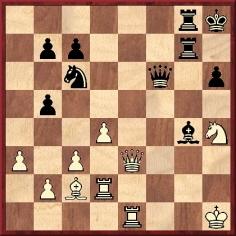
After 34 Rh2 Ne7 35 Ng2 Rg5, instead of 36 Be4 White could have won a piece with 36 Qxe7, and our correspondent therefore wonders whether the game-score is correct, and whether the move-order was perhaps 34...Rg5 35 Be4 Ne7 36 Ng2 c6.
Unable to trace the game-score in any 1914 source, we contacted Leonard Skinner (Cowbridge, Wales), who has kindly forwarded the earliest publication of the game known to him (as included in his book): Alekhine’s notes on pages 209-212 of Shakhmatny Vestnik, July 1915. The relevant phase is reproduced below:
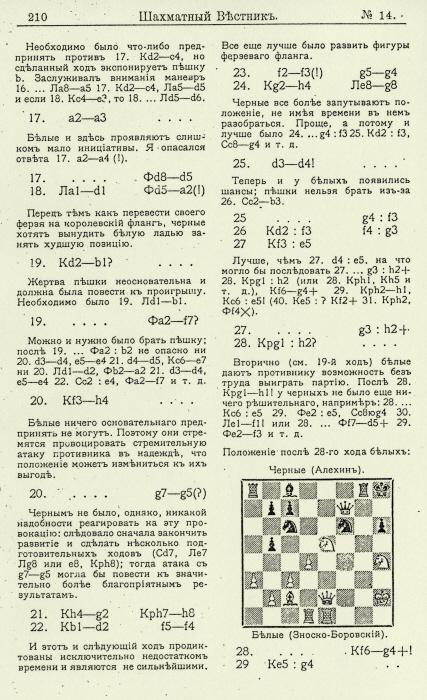
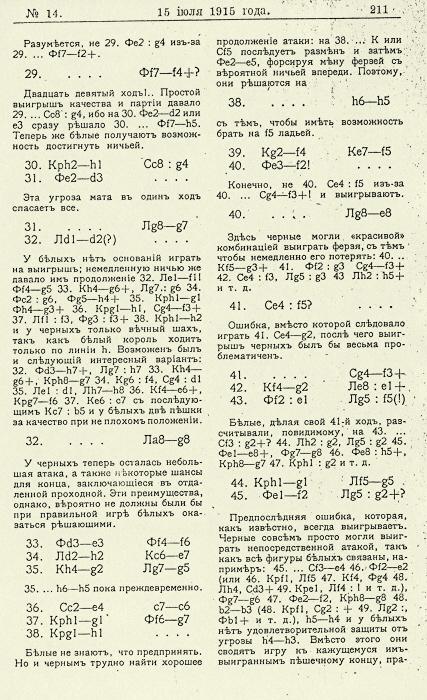
Given that the Skinner/Verhoeven book reproduced the game-score accurately, the question is whether an oversight occurred at the board at move 36 or whether Alekhine erred in the move-order which he submitted to the Russian periodical.
(5693)
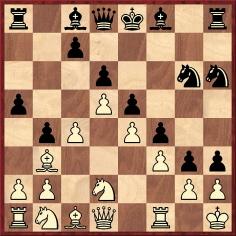
White to move
1 hxg3 hxg2+ 2 Kxg2 Bh3+ 3 Kxh3 Ng4+ 4 Kxg4 Qd7+ 5 Kg5 Be7+ 6 Kxg6 Rg8+ 7 Kh7 Bf6+ 8 Kxg8
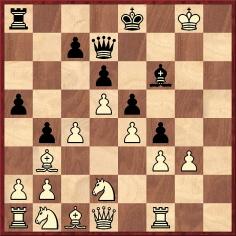
9...O-O-O mate.
This finish was given on page 78 of The Art of Chess Combination by E. Znosko-Borovsky (London, 1936):
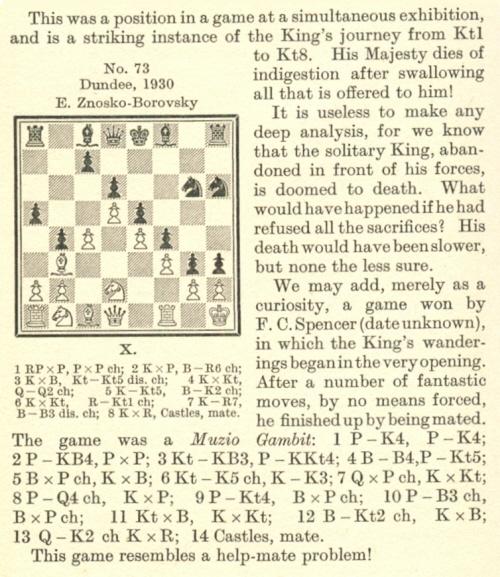
(For a discussion of the game won by F.C. Spencer, see pages 65-66 of A Chess Omnibus and C.N. 5594, as well as Castling in Chess.)
Regarding Znosko-Borovsky’s win against an unnamed opponent in Dundee in 1930, is it possible to find the full game-score? He performed two displays in that city (+2 –0 =0 and +13 –1 =1) on 22 November 1930, as reported on page 24 of the January 1931 BCM.
During a subsequent visit to Great Britain, Znosko-Borovsky gave a simultaneous exhibition in Bury St Edmunds (on 26 November 1932). G.H. Diggle offered his impressions on pages 2-3 of the January 1933 BCM. After quoting Staunton’s description of such displays as ‘that silliest of all chess exploits’ (see C.N. 4492), Diggle wrote:
‘That “silliest of all chess exploits”, however, has successfully stood the test of time, and will still draw the public as well as any other spectacle that the Royal game can give us. So we found on Saturday, 25 November [sic – Saturday, 26 November], at the Athenaeum, Bury St Edmunds, where Eugène Znosko-Borovsky “won 30 and lost 1” against the duly assembled “tenth-rate amateurs” of the West Suffolk and Ipswich Chess Clubs.
M. Znosko-Borovsky captivated the spectators, who included the Mayor and Mayoress of Bury St Edmunds, before he had been in action five minutes. We overheard one lady onlooker remark, not without a trace of disappointment, that “he wasn’t a bit like his name”, as the Russian master glided unobtrusively round the room for the first time, and played P-K4 on every board as quietly as one drops a lump of sugar into a cup of tea. But no – not on every board. One unfortunate wight at board No. 19, having anxiously witnessed 18 gentle pawn advances on the part of the approaching master, was utterly mesmerized by a sudden most uncalled for 1 KKt-B3 on his board, and it was not until M. Borovsky was half-way round again that he recovered sufficiently to mop his brow and exclaim to his neighbour, in awe-struck but injured tones, “What on earth has he done it to me for?”
M. Borovsky has not that ogreish voracity with which we once saw the world champion devour some 25 chess mortals at Scarborough, but he nevertheless gave us the impression of power. He flitted round and round those 31 citadels of West Suffolk like a graceful piece of light enemy aircraft; and as citadel after citadel collapsed, we were irresistibly reminded of Mr Baldwin’s words in a recent famous speech: “The bomber will always get through.”
We had, after the slaughter was over, the privilege of a few minutes’ talk with the conqueror. M. Borovsky had courteously consented to play with all sorts and conditions of chess-sets, and had frequently had to pass straight on from a graceful set of normal pattern to a collection of hideous monstrosities, like a model of Stonehenge, with the knights in some cases breathing over the heads of the very kings. We asked him whether this was a great handicap. M. Borovsky replied that in some cases care was necessary, but that fortunately the worst chess-sets were usually manipulated by the worst players. We asked him also if it was unduly fatiguing to him when players would not resign an obvious loss, but took “an unconscionable time a-dying”. But M. Borovsky smiled an indulgent smile. “They trouble me not”, he said, “ it is just that they like to see how one does the checkmate”.’
Diggle wrote very similarly about the display in an article in the July 1977 Newsflash which was reproduced on page 24 of Chess Characters (Geneva, 1984):
‘Eugène Znosko-Borovsky (1884-1954), though one of the select few who once beat Capablanca, was never one of the greatest Masters of his time. His chess career was upset by wars and political upheavals – indeed his military career did him great honour; he was severely wounded both in the Russo-Japanese War of 1905 and again in the First World War. It is as “perhaps the greatest teacher of elementary chess of all time” (R.N. Coles) that he will be best remembered.
The BM well remembers a simultaneous display that Znosko-Borovsky gave in 1933 [1932, in fact] at Bury St Edmunds (30 wins, and one loss to S.D. Ward). A small unassuming man “not a bit like his name” (as a lady onlooker remarked), he glided unobtrusively round the room and played 1 P-K4 on every board except the 19th, whose occupant, a well-known local farmer, after witnessing 18 gentle pawn advances by the approaching Master, was utterly mesmerized by a sudden most uncalled for 1 N-KB3 on his Board, and turned upon the BM who was on the next Board a countenance of motley pallor, and gasped: “What on earth did he do it to me for?”
The display lasted nearly four hours, which sounds a long time against an agricultural opposition of those days; but (1) many of his adversaries had brought their own chess sets (at the sight of which Bobby Fischer would have fainted away) – the knights in some cases were “breathing over the heads of the very kings”; (2) “Znosko” in fact had wins all over the place after the first hour, only to find that he was up against the finest Bitterenders in England. But the amiable Master had no complaints afterwards. In an “interview” he said that, as to (1) the worst chess sets were manipulated by the worst players; (2) as to the Bitterenders: “They trouble me not – it is just that they like to see how one does the checkmate.”’
(6809)

The 1933 BCM text by G.H. Diggle was also reproduced in C.N. 2955, accompanied by this caricature of Znosko-Borovsky on page [117] of Internationaal Schaaktournooi Zaanstreek 1946 by W.A.T. Schelfhout and C. Kottnauer (Amsterdam, 1946):
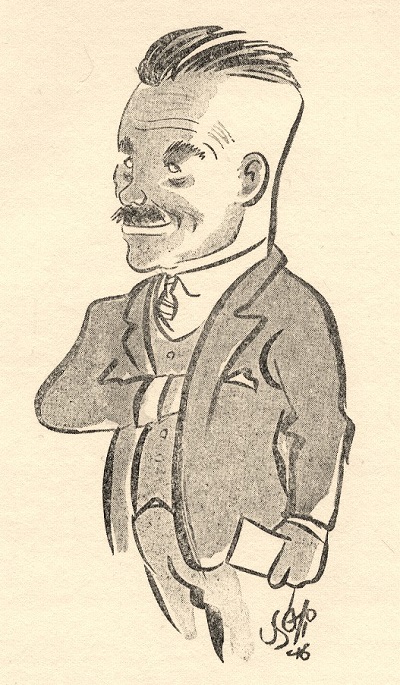
Further to the previous item, Eduardo Bauzá Mercére (New York, NY, USA) suggests a way of reaching the diagrammed position in N.N. v Znosko-Borovsky, Dundee, 1930:
1 e4 e5 2 Nf3 Nc6 3 Bb5 a6 4 Ba4 d6 5 d3 f5 6 Be3 f4 7 Bc1 g5 8 c3 g4 9 Nfd2 h5 10 d4 b5 11 d5 Nce7 12 Bb3 Nh6 13 f3 Ng6 14 c4 h4 15 Nc3 b4 16 Ncb1 a5 17 O-O h3 18 Kh1 g3.
As regards Znosko-Borovsky’s display in Bury St Edmunds on 26 (not 25, as stated in the BCM report) November 1932, Michael Clapham (Ipswich, England) notes that the game which deprived the master of a perfect score was given on page 106 of The Bury and West Suffolk Chess Club 1867-1977 by Adrian Thorpe (Preston St Mary, 1997):
Eugène Znosko-Borovsky – S. Donald Ward
Bury St Edmunds, 26 November 1932
Caro-Kann Defence
1 e4 c6 2 d4 d5 3 Nc3 dxe4 4 Nxe4 Bf5 5 Ng3 Bg6 6 h4 h6 7 Nf3 Nd7 8 Bd3 Bxd3 9 Qxd3 Ngf6 10 Bd2 e6 11 O-O-O Be7 12 Kb1 a5 13 Rhe1 Qc7 14 c4 Rd8 15 Ne2 Nc5 16 Qc3 Nce4 17 Qxa5 b6 18 Qa4 Nxf2 19 Bf4 Qb7 20 Rd2 Ra8 21 Qb3 N2e4 22 Rc2 O-O 23 Ng3 Nxg3 24 Bxg3 Ra5 25 c5 Rfa8 26 a3 b5 27 Ne5 Nd5 28 Rf2 Bf6 29 Nc4 R5a7 30 Nd6 Qa6 31 Be5
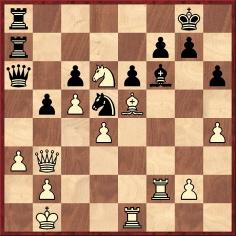
31...b4 32 Bxf6 Nxf6 33 Qxb4 Qd3+ 34 Rc2 Nd5 35 Qd2 Qb3 36 Kc1 Rb8 37 Kd1 Qg3 38 Qf2 Qd3+ 39 Kc1
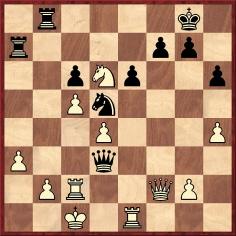
39...Nb4 40 Re3 Na2+ 41 Kb1 Nc3+ 42 White resigns.
An entry ticket was reproduced on page 43 of the book, which had a Foreword by S. Donald Ward.
(6810)
Olimpiu G. Urcan (Singapore) reports that a photograph of Eugène Znosko-Borovsky appeared on the front page of the Evening Telegraph and Post (Dundee, Scotland), 27 November 1936:
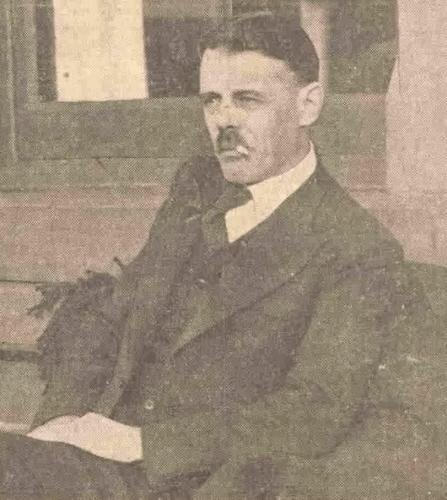
From page 93 of the February 1937 BCM:
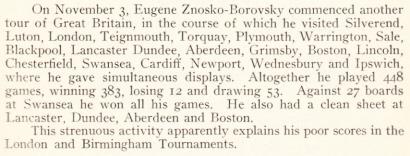
(8106)
From Oliver Beck (Seattle, WA, USA):
‘In Julien Gracq’s Un beau ténébreux (Paris, 1945) a character’s chess is described as follows:
“Il joue remarquablement, avec une prédilection pour les parties fermées, la Sicilienne, l’Ouest-Indienne, comme tous les joueurs qui sentent ces relations secrètes de case à case qui sommeillent sur l’échiquier, cette puissance explosive latente qui dort dans chaque pièce, et dont l’appréhension intuitive fait toute la supériorité du jeu de fakirs, comme Alekhine, comme Breyer, comme Botwinnik, sur les géomètres [Gracq’s emphasis] de l’échiquier qu’étaient un Morphy ou un Rubinstein” (pages 67-68 in the 1983 José Corti edition).
This description, with the somewhat surprising insertion of Breyer between Alekhine and Botvinnik, may be better understood in light of Gracq’s comment in Lettrines 2 (Paris, 1974):
“... puis, en 1929, le livre de Réti: Modern Ideas in Chess, qui est un peu le Manifeste du Surréalisme échiquéen, me donna à Londres tout un été de découverte et de bonheur” (page 176 in the 1978 José Corti edition).
Elsewhere in Lettrines 2, Gracq describes an encounter with E. Znosko-Borovsky:
“Une fois, avec le président du cercle d’échecs de Quimper, nous y conduisîmes Znosko-Borovsky, célèbre joueur d’échecs, que nous avions invité dans notre ville pour une conférence et une séance de simultanées; avec sa moustache taillée en brosse, il avait l’air d’un gentil et courtois bouledogue. Je ne sais pourquoi je le revois encore parfaitement, silhouetté au bord de la falaise, regardant l’horizon du Sud: il y avait dans cette image je ne sais quoi d’incongru et de parfaitement dépaysant. Il ne disait rien. Peut-être rêvait-il, sur ce haut lieu, à la victoire qu’il avait un jour remportée sur Capablanca” (page 38).
Gracq’s reference to Capablanca v Znosko-Borovsky, St Petersburg, 1913 may not seem unusual; it was annotated in the illustrative games section of Capablanca’s Chess Fundamentals and touched upon in Chapter VII of My Chess Career. However, it causes me to wonder whether Znosko-Borovsky ever mentioned it in his writings. Also, considering Capablanca’s incredible success during his second European tour, how much attention was paid to Znosko-Borovsky’s victory at the time?’
Znosko-Borovsky discussed part of his victory over the Cuban on pages 152-156 of his book The Middle Game in Chess (London, 1922). The full score was published, with notes by both Znosko-Borovsky and Capablanca on pages 189-190 of issue 22 of Les Cahiers de l’Echiquier Français (1930), incorrectly labelled a tournament game:
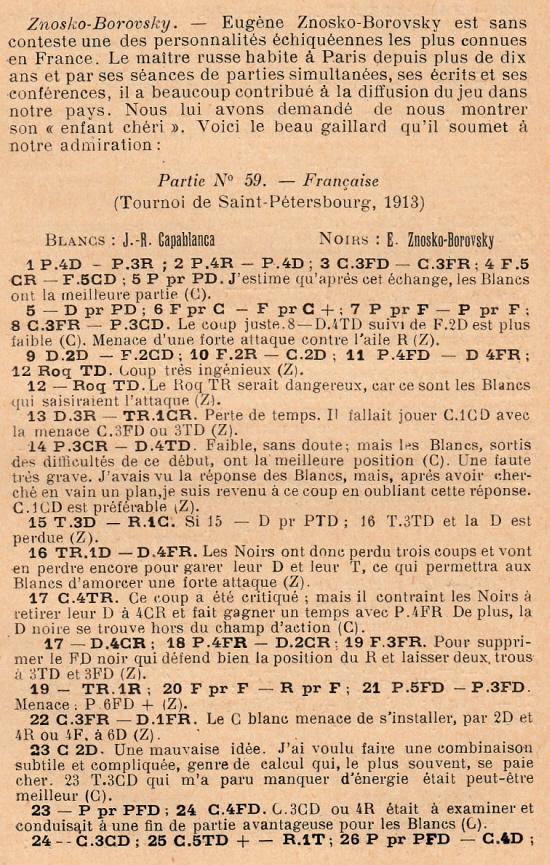
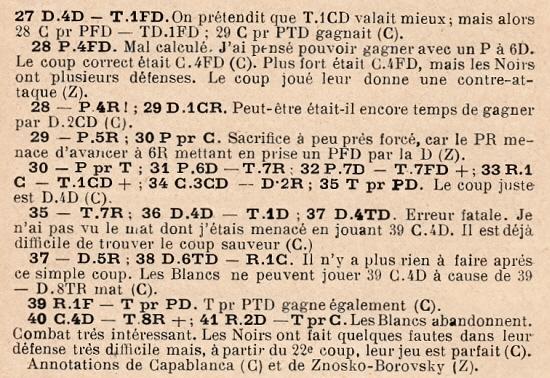
Capablanca’s earliest set of notes to the game appeared on pages 19-20 of the January 1914 issue of La Stratégie:
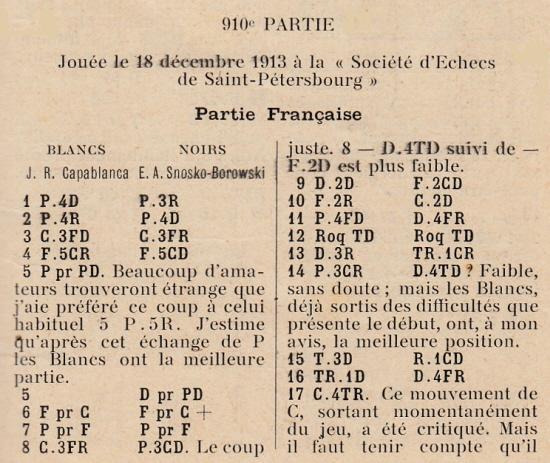
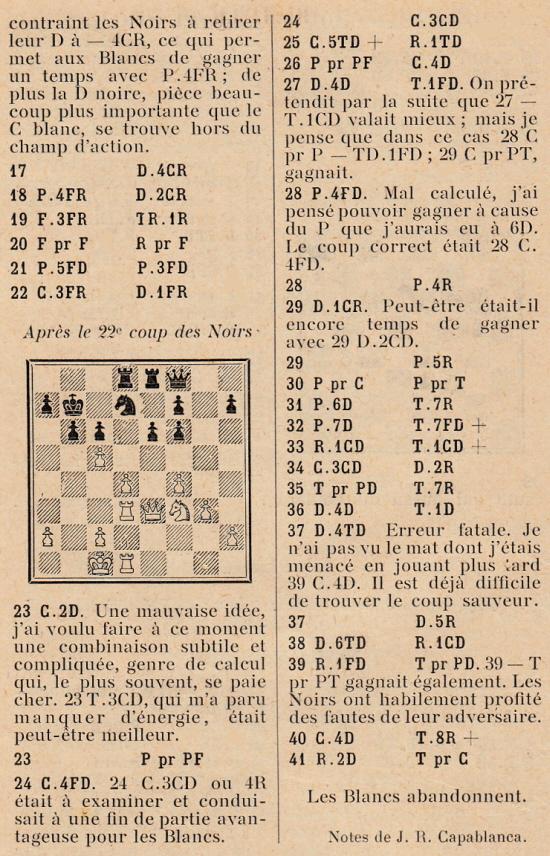
Both French publications stated that the game ended 41 Kd2 Rxd4 42 White resigns, whereas in Chess Fundamentals Capablanca wrote that he resigned after 40...Re1+.
The game was widely published at the time, without receiving special attention.
(8631)
The Best Chess Games includes, from the 1930s series in Les Cahiers de l’Echiquier Français, Znosko-Borovsky’s nomination: Capablanca v Znosko-Borovsky, St Petersburg, 1913 (volume 2, pages 189-190).
From our feature article Chess Photographs in the Daily Mirror:
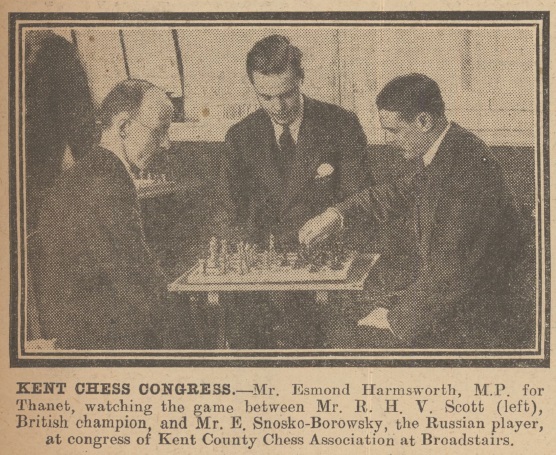
28 March 1921, page 12
Olimpiu G. Urcan has found the cuttings presented below:
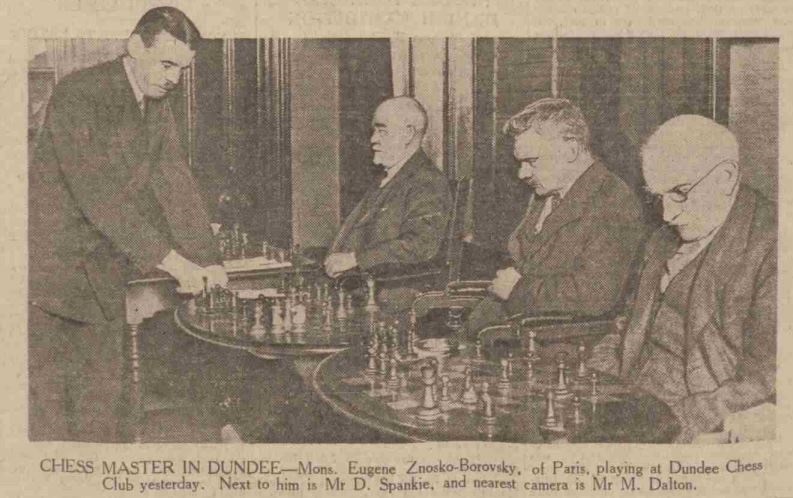
Dundee Courier, 16 November 1932, page 8.
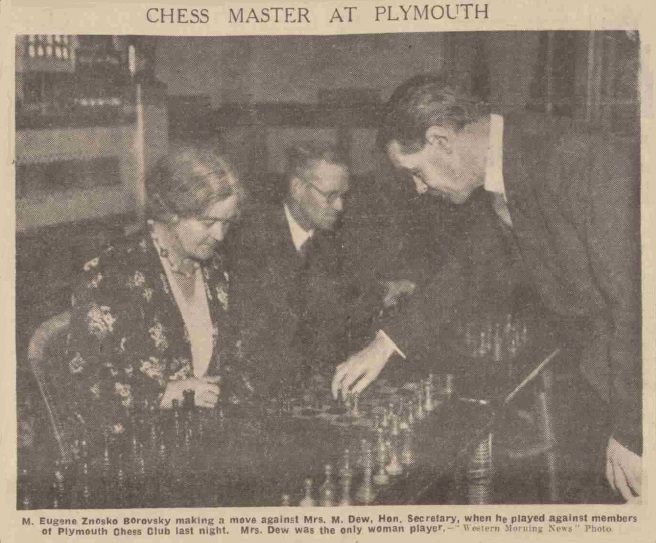

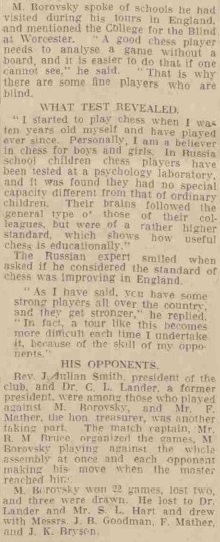
Western Morning News and Daily Gazette, 20 November 1936, page 7.
(8960)
A caricature of Znosko-Borovsky at London, 1922 was given in C.N. 8982 from page 261 of The Graphic, 19 August 1922, as contributed by Gerard Killoran (Ilkley, England)
From page 82 of CHESS, March 1941:
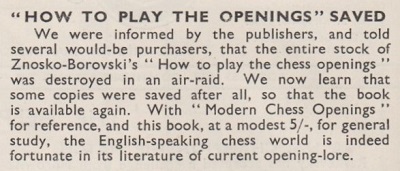
Below is an entry about Znosko-Borovsky’s book on page 204 of Douglas A. Betts’ Annotated Bibliography:
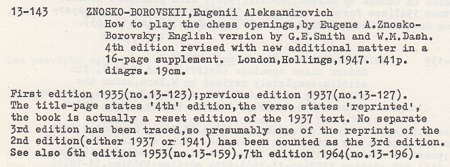
Three of our copies of Znosko-Borovsky’s book have an imprint page stating ‘Reprinted 1941’. In each case the title page specifies ‘Second Edition revised ...’, and no copy with ‘Third Edition’ on the title page has been found.
(9173)
On page 192 of the US edition of his book on Morphy (New York, 1859) F.M. Edge wrote that Anderssen ‘played that disgusting arrangement, the Ruy López’. A twentieth-century master who made surprisingly negative comments about that opening was E.A. Znosko-Borovsky, in an article on pages 105-108 of Le monde des échecs, May 1946. Below are the first page and the last two paragraphs:
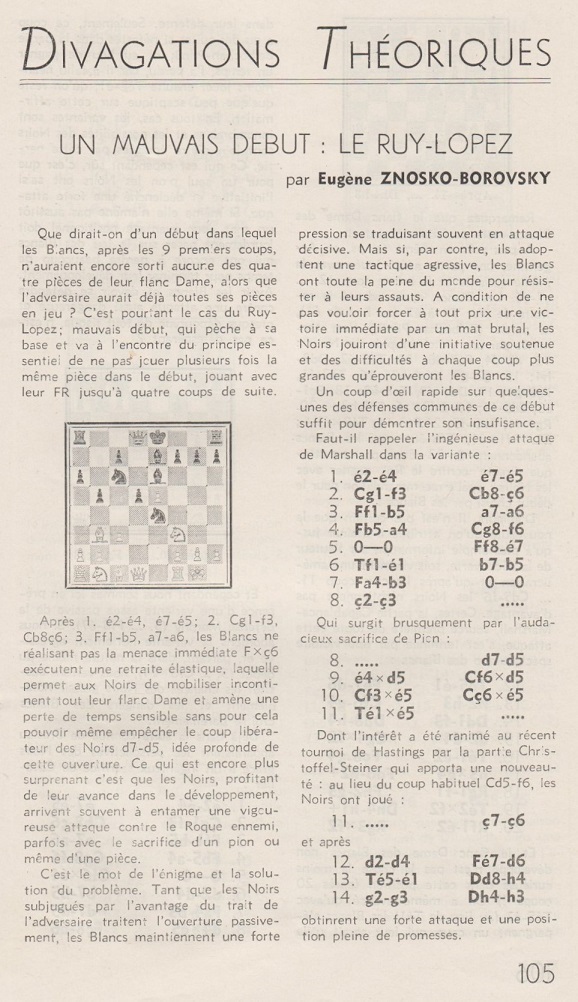
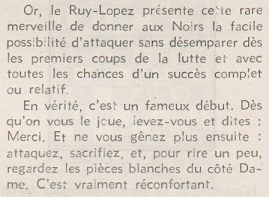
E.A. Znosko-Borovsky’s article in Le monde des échecs appeared in an English translation, ‘The Ruy López: A Bad Opening’, on pages 234-237 of Chess World, 1 December 1946. In his introduction Purdy wrote:
‘Even beginners know that the Ruy López has long been considered the strongest opening for White. This is therefore the most provocative article on chess theory ever published.’
See too ‘The Ruy’s Revenge’ by W. Ritson Morry on pages 17-19 of CHESS, October 1947; the second of two annotated games was Znosko-Borovsky’s (readily available) loss to K.P. Charlesworth at Harrogate in August 1947, on the black side of a Ruy López.
(9305)
Olimpiu G. Urcan added this cutting in C.N. 10926:
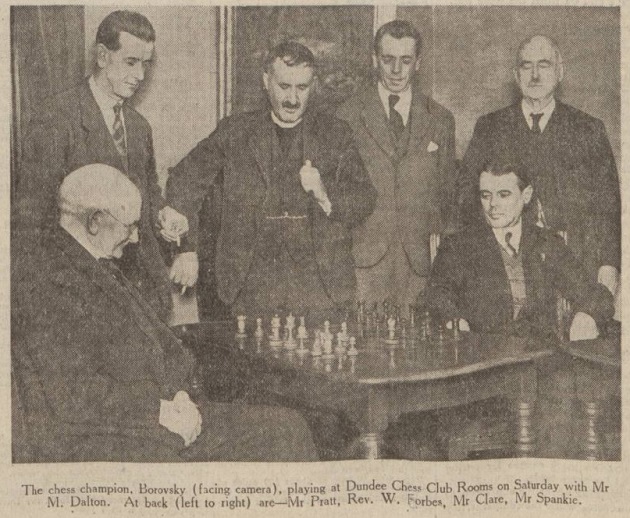
Courier and Advertiser (Dundee), 24 November 1930, page 5
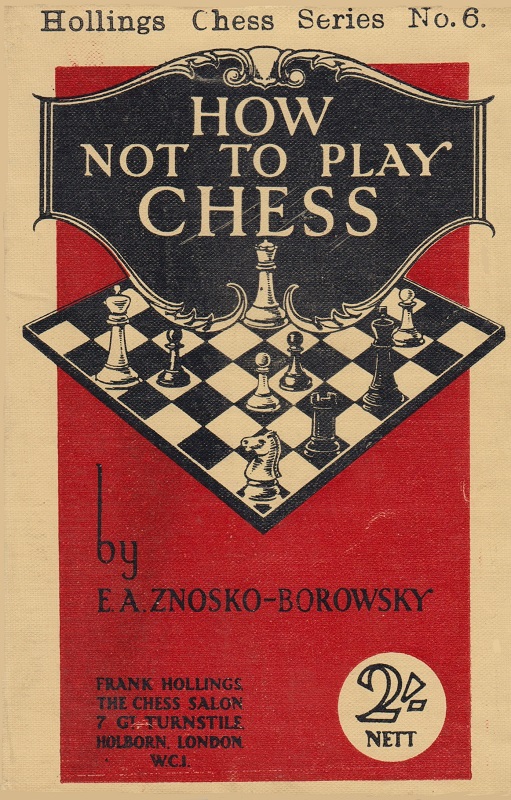
‘We can gain nothing in chess except by means of threats.’
That observation is on page 69 of How Not to Play Chess by E. Znosko-Borovsky (London, 1931):
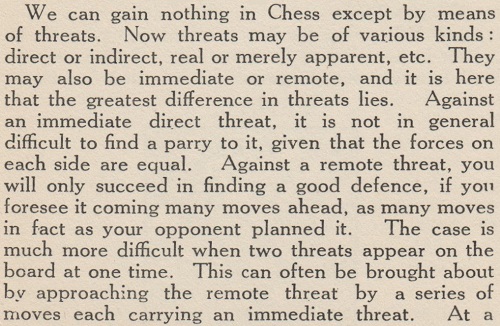
A dissenting note appeared in a book review by Charles De Vide on page 73 of the April 1932 American Chess Bulletin:

(11408)
From Chess Anecdotes:
Under the title ‘Or So They Say’ CHESS (14 April 1939, pages 276-277) stated:
‘E.A. Znosko-Borovsky published an article recently entitled “The bad moves of Dr Max Euwe”. Dr Euwe, always the gentleman, considered responding by means of a booklet entitled “The good moves of Znosko-Borovsky”, but couldn’t get hold of any material.’
From page 325 of The Golden Dozen by Irving Chernev:
‘Eugene Alexandrovich Znosko-Borovsky (a resonant name if ever there was one) once published a monograph called “Capablanca’s Mistakes”. Capablanca’s response to this was to tell the author that he had tried to write a work called “Znosko-Borovsky’s Good Moves”, but had to give it up as he could not find enough material.’
(1562)
Znosko-Borovsky wrote an article entitled ‘Capablanca’s Fehler’ in the January-March 1926 issue of Kagans Neueste Schachnachrichten (pages 150-154). Around the same time he published a critical article in L’Echiquier (February 1926, pages 26-27) called ‘Capablanca’s Fehler’.
We have found no trace of a reply by the Cuban.
(1618)
On page 20 of the April 1994 Chess Life, Andy Soltis rehashes a rickety anecdote:
‘Shortly after José Capablanca became world champion Znosko-Borovsky published a booklet of the Cuban’s losses called Capablanca’s Errors. Asked about it, Capa said he hoped to write a book called Znosko-Borovsky’s Good Moves but, he said, “Unfortunately, I didn’t succeed in finding material for it”.’
Mr Soltis provides no evidence regarding Znosko-Borovsky’s alleged booklet or Capablanca’s alleged dialogue. (We can add that Znosko-Borovsky did write an article called ‘Capablanca’s Fehler’ on pages 150-154 of the January-March 1926 Kagans Neueste Schachnachrichten; it discussed positions from seven games, four of which the Cuban won.)
A similar tale, with Euwe replacing Capablanca, appeared on pages 276-277 of the 14 April 1939 issue of CHESS.
(2032)
From page 54 of the February 1927 Wiener Schachzeitung:
That was in a spoof issue (4/1927), comprising jokes and parodies. See C.N. 6452 for another example, concerning Alekhine.
Some further citations:
- ‘When the Russian Master, Eugene Alexandrovich Znosko-Borovsky, published a booklet entitled Capablanca’s Mistakes, Capa was not slow to announce that he had tried to write a book called Znosko-Borovsky’s Good Moves, but had renounced the project in despair at the lack of material.
Of Capablanca’s own games it has been written, with justice, that they breathe a serenity, a lucid crystal clarity, a type of model perfection. Indeed, that they are the product of supreme chessboard art.’
Raymond Keene, on page 40 of The Times (Review Section), 19 November 1988;
- ‘When the Russian master, Eugene Alexandrovich Znosko-Borovsky, published a booklet entitled Capablanca’s Mistakes, Capa was not slow to announce that he had tried to write a book called Znosko-Borovsky’s Good Moves, but had renounced the project in despair at the lack of material.
Of Capablanca’s own games it has been written, with justice, that they breathe a serenity, a lucid crystal clarity, a type of model perfection. Indeed, that they are the product of supreme chessboard art.’
Raymond Keene, on page 236 of Keene On Chess (New York, 1999);
- ‘When the Russian master, Eugene Alexandrovich Znosko-Borovsky, published a booklet entitled Capablanca’s Mistakes, Capa was not slow to announce that he had tried to write a book called Znosko-Borovsky’s Good Moves, but had renounced the project in despair at the lack of material.
Of Capablanca’s own games it has been written, with justice, that they breathe a serenity, a lucid crystal clarity, a type of model perfection. Indeed, that they are the product of supreme chessboard art.’
Raymond Keene, on page 237 of Complete Book of Beginning Chess (New York, 2003);
- ‘When the Russian chess master, Eugène Znosko-Borovsky, published a booklet entitled Capablanca’s Mistakes, Capa was not slow to announce that he had tried to write a book called Znosko-Borovsky’s Good Moves, but had renounced the project in despair at the lack of material.
Of Capablanca’s own games it has been written, with justice, that they breathe a serenity, a lucid crystal clarity, a type of model perfection. Indeed, that they are the product of supreme chessboard art.’
Raymond Keene, on pages 40-41 of World Chess Championship Kramnik vs. Leko (Aylesbeare, 2004);
- ‘When the Russian chess master, Eugène Znosko-Borovsky, published a booklet entitled Capablanca’s Mistakes, Capa was not slow to announce that he had tried to write a book called Znosko-Borovsky’s Good Moves, but had renounced the project in despair at the lack of material.
Of Capablanca’s own games it has been written, with justice, that they breathe a serenity, a lucid crystal clarity, a type of model perfection. Indeed, that they are the product of supreme chessboard art.’
Raymond Keene, on page 34 of Vishy’s Victory (2007);
- ‘When the Russian chess master, Eugène Alexandrovich Znosko-Borovsky, published a booklet entitled Capablanca’s Mistakes, Capa was not slow to announce that he had tried to write a book called Znosko-Borovsky’s Good Moves, but had renounced the project in despair at the lack of material.
Of Capablanca’s own games it has been written, with justice, that they breathe a serenity, a lucid crystal clarity, a type of model perfection. Indeed, that they are the product of supreme chessboard art.’
Raymond Keene, on page 21 of Battle of Bonn (2008);
- ‘When the Russian master, Eugene Alexandrovich Znosko-Borovsky, published a booklet entitled Capablanca’s Mistakes, Capa was not slow to announce that he had tried to write a book called Znosko-Borovsky’s Good Moves, but had renounced the project in despair at the lack of material.
Of Capablanca’s own games it has been written, with justice, that they breathe a serenity, a lucid crystal clarity, a type of model perfection. Indeed, that they are the product of supreme chessboard art.’
Raymond Keene, on page 58 of Carlsen-Anand Match for the World Chess Championship (Bronx, 2013).
As regards the second paragraph in each of those seven passages, the uncredited writer of the ‘lucid crystal clarity’ remark was Harry Golombek, on page ix of Capablanca’s Hundred Best Games of Chess.
(10316)
On page 84 of Chess An Illustrated History (Oxford, 1990) Raymond Keene gave another version of the quote about Capablanca:
‘Of his games, it has been declared that they breathe “a serenity, a crystal clarity, a perfection which is the result of the highest art”.’
Yuri Kireev (Moscow) provides page 22 of the 2/1914 edition of Столица и усадьба. The article by E.A. Znosko-Borovsky features Prince Gedroiz/Gedroits:
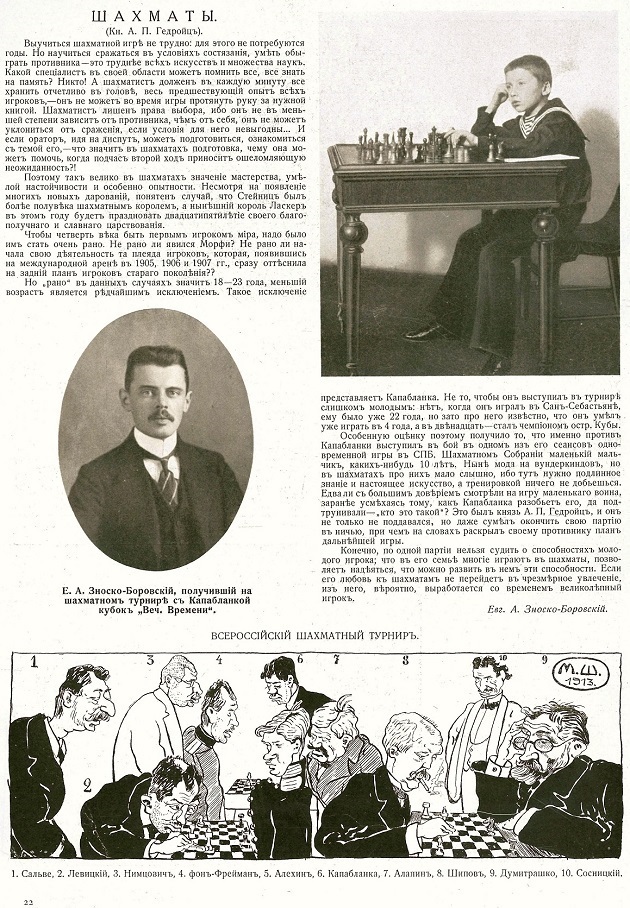
Mr Kireev comments that the cartoon includes Capablanca even though he was not a participant in the event concerned, the All-Russian Tournament in St Petersburg (won jointly by Alekhine and Nimzowitsch).
(11358)
To the Archives
for other feature articles.
Copyright Edward Winter. All rights reserved.